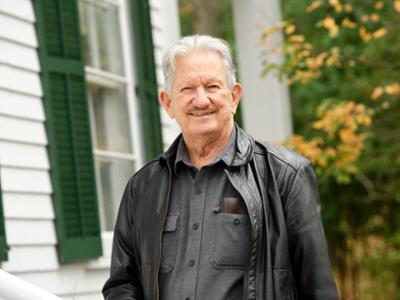Rand Carter

Rand Urban Carter (1937-2025)
Presented October 2025 by Deborah Pokinski, associate professor of art history emerita
Rand Carter, professor of art history emeritus, died on June 12, 2025, at the age of 87. Rand joined the Hamilton faculty in 1970 and taught on College Hill for 47 years until his retirement in 2017. As the College’s first art historian, he established the Art History Program, which later became a department.
Born in Corpus Christi, Texas, on Sept. 17, 1937, Rand was the youngest of five children. His lifelong passion for the arts began early, with piano lessons at age 6 and participation in a children’s theatre company soon after.
In 1955, Rand left Texas to attend Columbia University where he developed a serious interest in art history, inspired by the university’s esteemed faculty. While in New York City, he did not resist indulging his love for music and theatre by attending and reviewing performances for a local weekly radio program.
After completing his undergraduate degree in 1959, Rand began graduate studies in art and archaeology at Princeton, earning an MFA degree in 1961. That same year, he received a Fulbright Scholarship to study in London at the prestigious Courtauld Institute of Art. He completed his Ph.D. in 1966.
After returning from England in 1962, Rand taught at McGill University in Montreal for eight years before joining the Hamilton faculty in 1970.
Rand’s scholarly focus was on neoclassical architecture in mid-19th century Prussia, particularly the work of Karl Friedrich Schinkel. His 1970 article, titled “Schinkel’s Modern Classicism,” positioned him as a leading voice during the resurgence of interest in Schinkel in a period marked by the shift from Modernism to Post-modernism. His influence was recognized in 1981, on the occasion of Schinkel’s 200th birthday, when he contributed a prefatory essay to a facsimile edition of Schinkel’s Collection of Architectural Designs (Sammlung architektonischer Entwurfe), originally published in 1866. The appearance of a comprehensive contemporary record of Schinkel’s architectural designs, enhanced by Rand’s contextual essay, underscores the significance of Schinkel’s work and the study of it at a critical transitional moment in recent architectural history. Rand published five more articles on Schinkel, co-founded the Friends of Schinkel in 1995, and helped organize an international Schinkel celebration in 2000.
During his tenure at Hamilton, Rand taught a wide range of courses, including European Art and Architecture from the 17th Through 19th Centuries, Modern Architecture, Urban and Landscape Design History, and The Environmental Implications of Architectural Design. He helped establish an important template for the Hamilton art history curriculum based on breadth of offerings and depth of faculty expertise. In particular, the department’s long-standing strength in architectural history was initiated by Rand’s example and commitment to his signature subject.
Rand actively engaged with the arts in every community he lived in, including Central New York. He authored definitive works on local architecture, such as Philip Johnson’s Munson Museum (formerly the Munson-Williams-Proctor Arts Institute) and Utica’s 19th-century Greek Revival colossus, the “Old Main” building at the State Hospital/Lunatic Asylum. He also wrote three guidebooks to local art and architecture. And, before the merger of Hamilton and Kirkland colleges, he curated and wrote catalogues for at least 10 art exhibitions at the Root Art Center, a predecessor to today’s Wellin Museum.
Rand also served on the boards of numerous community arts organizations, including the Players of Utica, the Utica Symphony, the Clinton Symphony, and the Chamber Music Society of Utica. He was president of the Landmarks Society of Greater Utica, receiving a Distinguished Service/Lifetime Achievement Award from them in 2011. And, he was a board member of Sculpture Space for 16 years, as well as board president.
I’ll finish with three more personal observations: Rand loved big Chrysler convertibles. He loved Egypt; thought of it as a second home. And, Rand maintained long and meaningful friendships with many former students, evidenced by the celebratory event they organized for his retirement in 2017 and their presence at his recent funeral services.
